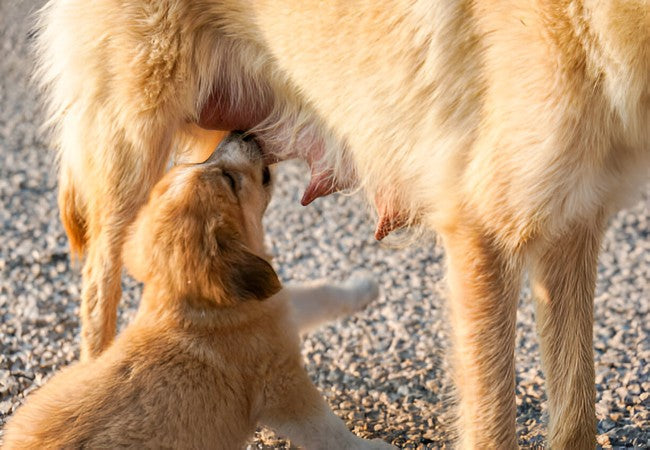Vet’s 2025 Guide to Mastitis in Dogs 🩺🐶

In this article
Vet’s 2025 Guide to Mastitis in Dogs 🩺🐶
By Dr. Duncan Houston BVSc
Mastitis in dogs is an inflammation, often a bacterial infection, of the mammary glands, typically during or after nursing. This common but potentially serious condition requires prompt veterinary care. This 2025 guide covers causes, clinical signs, staging, diagnostics, proven treatments (antibiotics, hand-milking, compresses), and at-home supportive care—plus telehealth and enrichment support via Ask A Vet. 🐾
1️⃣. What Is Mastitis?
Mastitis is inflammation of one or more mammary glands, often due to bacteria entering the gland via teat trauma or milk stasis, but can occasionally be non-septic. Most common in postpartum nursing females, sometimes seen in false pregnancies or very rarely in males.
2️⃣ . Who’s at Risk?
- Nursing bitches—especially after sudden weaning or puppy death, leading to milk buildup.
- Dogs living in unsanitary conditions or with teat trauma.
- Non-nursing dogs during false pregnancies or bacteria from bloodstream.
3️⃣ Recognizing Signs
- Hot, firm, swollen gland(s), often painful to touch.
- Discolored milk—cloudy, bloody, or containing pus.
- Mild cases may only show poor puppy weight gain.
- Severe signs include fever, anorexia, lethargy, vomiting, diarrhea, sepsis, and refusal to nurse.
- Gangrenous mastitis shows purple/black tissue, shock signs—life-threatening.
4️⃣ Diagnosing Mastitis
- Physical exam: palpation, pain assessment.
- Milk cytology/culture: detect bacteria, guide antibiotics.
- CBC/biochemistry: assess infection severity and sepsis indicators.
- Ultrasound or X-ray for abscesses/necrosis in severe or chronic cases.
- In non-nursing females/males, biopsy or imaging to rule out mammary tumors.
5️⃣ Treatment Strategies
🐾 Antibiotic & Medical Therapy
- Empirical broad-spectrum antibiotics (e.g., amoxicillin-clavulanate, cephalosporins), adjust after culture (2–3 weeks).
- Analgesics and anti-inflammatories to manage pain and fever.
- Hospitalization, IV fluids for septic or gangrenous cases; surgical removal of necrotic tissue may be required.
🍼 Hand-Milking & Nursing
- Encourage puppies to nurse to clear milk—can help recovery.
- If too painful, gently hand-milk every 4–6 hours.
🌿 Compresses & Supportive Care
- Warm compresses, cabbage leaves applied intermittently for comfort.
- Maintain hygiene; clean bedding and whelping area daily.
- Provide soft, palatable food and hydration.
6️⃣ Monitoring & Prognosis
- Recheck every 2–4 days until resolution; monitor fever, appetite, gland appearance.
- Antibiotics usually resolve mild acute cases in 2–3 weeks.
- Subclinical mastitis often only detected by poor puppy growth.
- Severe cases: Sepsis can be fatal, and gangrenous tissue may necessitate glandular removal.
7️⃣ Prevention Tips
- Keep whelping boxes clean and dry; check glands daily.
- Avoid abrupt weaning—gradual transition helps prevent milk accumulation.
- Promptly treat teat injuries or inflammation.
- Consider spaying non-breeding dogs to prevent recurrence or false pregnancies.
8️⃣ Supportive Care & Brand Integration
- Ask A Vet: Telehealth follow-ups for antibiotic efficacy, comp questions, and milk management.
9️⃣ When to Call the Vet Immediately
- Signs of sepsis—fever, vomiting, diarrhea, collapse.
- Gland discoloration (purple/black), severe pain or necrosis.
- Puppies failing despite nursing; maternal refusal to nurse.
- No improvement within 48–72 hours of treatment.
🏁 Final Thoughts
Mastitis is common in nursing dogs but typically responds well to timely treatment: antibiotics, milk clearance, and compresses support healing. Severe cases can be life-threatening, so act fast. By 2025, a combination of telehealth support through Ask A Vet and comforting tools ensures moms—and their babies—get the best care possible. 🐾❤️
Need help with medication schedules, hand-milking technique, or discharge monitoring? Visit AskAVet.com and download the Ask A Vet app for expert guidance anytime. 📱🐶






